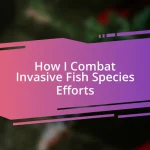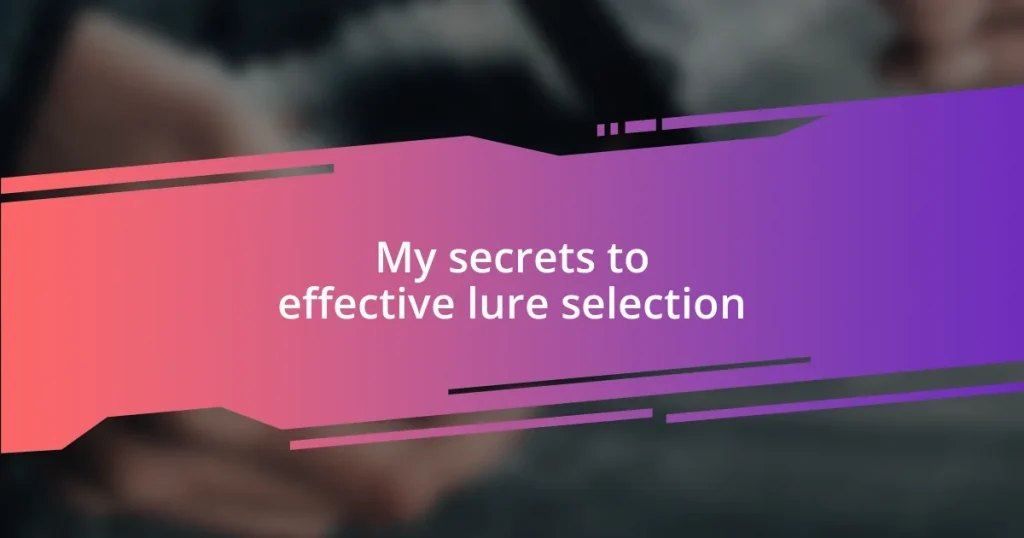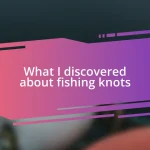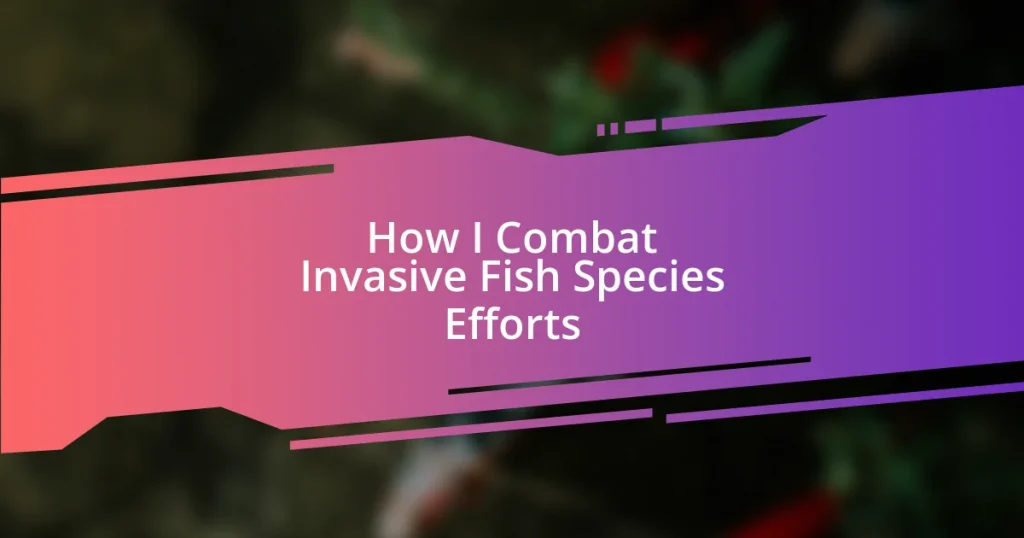Key takeaways:
- Understanding fish behavior and adapting lure selection based on seasonal and environmental conditions can significantly enhance fishing success.
- Choosing the right lure type, color, size, and shape tailored to specific circumstances is crucial for attracting target fish.
- Common mistakes include rigidly sticking to favorite lures, ignoring local forage, and underestimating the importance of lure size.

Understanding fish behavior
Understanding fish behavior is crucial to selecting the right lure, and I’ve often found that observing their patterns can feel like unlocking a secret code. For instance, while fishing one sunny afternoon, I noticed how the bass were hovering near submerged rocks. It struck me how they seemed to prefer the shade, which made me rethink my lure choice to something more natural and less flashy.
Fish behavior varies greatly based on seasons and water conditions. Have you ever considered why some days are more productive than others? When temperatures drop, fish tend to become sluggish, often hiding in deeper waters. This understanding led me to adapt my strategies, switching to heavier lures that could sink deeper, giving me access to those reluctant fish.
I remember a rainy day when the water was murky, and it felt like a lost cause. Yet, I decided to switch to a bright-colored spinner. It was fascinating to see how the fish reacted to that sudden splash of color amid the gloom, darting out from their hiding spots to chase my lure. It made me realize that even the smallest changes in the environment could dramatically influence fish behavior, reinforcing the need to remain flexible and observant in our approach.

Choosing the right lure type
Choosing the right lure type can truly make or break your fishing trip. I still vividly remember the first time I stepped into a calm lake at dawn, armed with nothing but a box of colorful lures. I experimented with various types, but it was the soft plastic worms that proved irresistible to the nearby trout. The thrill of feeling that first tug on the line is a moment I cherish, reinforcing the idea that matching the lure to fish preferences is essential.
When selecting a lure type, consider these key elements:
- Water Conditions: Clear, murky, or stained? Each condition demands a different lure choice.
- Species Targeted: Different fish have different feeding habits; crankbaits for active predators, soft plastics for bottom feeders.
- Weather Conditions: Overcast days often call for brighter colors to stand out, while sunny days might benefit from more natural hues.
- Time of Year: In Spring, fish may prefer faster-moving lures, while in Fall, slower presentations might work better as they prepare for winter.
With these insights, you’re better equipped to choose a lure that will enhance your fishing experience.

Best colors for specific conditions
When it comes to lure colors, the right choice can significantly impact your success, especially under varying conditions. I’ve always found that clear, sunny days beg for natural tones like greens and browns, as these blend seamlessly with the environment. On the contrary, during overcast periods, bright colors such as chartreuse or orange can really stand out, capturing the attention of lurking fish. Isn’t it fascinating how light conditions can play such a pivotal role in your catch rate?
I also remember fishing in murky waters after a heavy rainstorm; the visibility was poor, and my confidence dipped along with the sunlight. I decided then to try a vivid red crankbait. To my surprise, the fish were still very active, and that bold splash of color cut through the gloom, resulting in several strikes. It reminded me that even in less-than-ideal circumstances, the right lure color can be a game changer, reflecting the essence of adaptability in fishing.
Lastly, don’t underestimate the impact of seasonal changes on color selection. In spring, I often favor pastel hues to mimic the subtle colors of young baitfish, while in late summer, I’ve had tremendous luck with more vibrant shades that capture the energetic feeding patterns of fish preparing for fall. Color versatility is a key strategy that I’ve honed over the years, and adapting to the conditions can lead to remarkable outcomes.
| Water Condition | Best Lure Colors |
|---|---|
| Clear | Natural Greens/Browns |
| Murky | Vivid Reds/Yellows |
| Overcast | Bright Chartreuse/Orange |
| Spring | Pastel Shades |
| Late Summer | Vibrant Hues |

Size and shape considerations
When it comes to lure selection, size and shape play a crucial role that often gets overlooked. I remember one fishing trip where I was convinced larger lures were the way to go. With high hopes of landing a trophy fish, I tied on a hefty topwater plug. To my dismay, it barely drew a glance. It was only when I switched to a smaller, more streamlined profile that I began to see those exciting strikes. Doesn’t it make you think about how a slight adjustment can yield such different results?
The shape of a lure can either mimic natural prey or stand out in the water, and balancing that is key. On one outing, I experimented with a paddle-tail soft plastic that captured the undulating motion of baitfish perfectly. Watching it swim through the water, I felt a surge of excitement as fish darted toward it, and it made me realize how shape can influence a fish’s interest. Isn’t it remarkable how fish are programmed to respond to certain shapes?
Lastly, the size of your lure should align with the species you’re targeting. I’ve had days where using a larger lure for bass resulted in nothing but frustration, while downsizing led to constant action. Remember that the fish has a preference too! You’re not just trying to appeal to their appetite but also their instincts. Have you tried matching the size of your lure to the forage present in the area? That simple tweak can transform your fishing experience, making your outings not just productive but genuinely enjoyable.

Techniques for lure presentation
One technique that has always worked for me is varying the speed of my lure presentation. I distinctly remember a day on the water when a slow, steady retrieve yielded nothing. Frustrated, I decided to mix it up with a quick, erratic twitching motion. Suddenly, I was getting bites left and right! It was a great reminder that fish are often motivated by a sense of urgency, and sometimes a little change can create a frenzy. Have you ever thought about how your speed could be affecting your strike rate?
Another method I’ve found effective is incorporating pauses into my retrieval. During one memorable afternoon, I was using a jerkbait and cycling through some standard retrieval patterns. After not getting any attention, I made the decision to pause for a moment after every few pulls. It was as if a light bulb went off—the fish came rushing in! Those pauses can mimic the natural movements of prey, triggering instinctual responses in fish. Isn’t it fascinating how a moment of stillness can invite action?
Lastly, consider the angle of your presentation. I often position my cast at different angles, particularly when targeting fish around structure. Once, while fishing near some sunken timber, I initially cast parallel to the logs with little success. After some thought, I switched to casting at a sharper angle, allowing my lure to drift more naturally around the structure. That subtly changed my results completely! Have you ever noticed how repositioning your cast can open up new opportunities? It’s all about being adaptable and listening to the water around you.

Seasonal lure selection strategies
Seasonal changes can greatly influence a fish’s feeding habits, which in turn affect my choice of lures. For instance, during the warmer months, I often find that bright and vibrant colors work wonders as they mimic the more active baitfish. I recall a summer trip where I switched from subtle earth tones to a vivid chartreuse, and it felt like flipping a switch—the bites were relentless! It makes me wonder, do you pay attention to seasonal color shifts in your lure selection?
As temperatures drop in the fall, I shift my strategy to heavier, more subdued lures that mimic the slower, deeper movement of baitfish seeking refuge. I’ve had success with metal jigs during those crisp morning hours, feeling that satisfying thud when I connected with a big lake trout. The way fish respond to seasonal movements makes me think about how critical timing is—have you noticed the difference in your results when you align your lure with the season?
In winter, I often resort to smaller, more delicate lures, focusing on finesse techniques that require patience. One cold day on the ice, I was using a tiny tungsten jig tipped with a waxworm. I remember the thrill of watching the line go slack before a steady pull indicated a bite. That moment taught me the importance of adapting my lure choice to the dwindling energy levels of fish in colder months. Have you experimented with size and delicacy in winter fishing? It’s incredible how much of a difference it can make!

Common mistakes in lure selection
One common mistake I see is sticking too rigidly to a favorite lure, even when conditions change. I remember a particular outing where I was convinced my go-to spinnerbait would work, despite the cloudy weather and murky water. I ended up with nothing until I finally decided to try a more vibrant rattletrap. The change resulted in a flurry of bites, proving that adaptability in lure selection can be crucial. Have you ever clung to a lure out of habit and missed out on catching?
Another error I often notice is overlooking local forage. I recall a fishing trip where I passionately tossed a plastic worm, convinced it was the ultimate choice. It wasn’t until I spotted schools of shad swimming by that I realized I was fishing with the wrong presentation entirely. Matching your lure to the actual baitfish in the area can make a monumental difference. How closely do you observe what’s happening around you when choosing your lures?
Lastly, many anglers underestimate the importance of lure size. I once learned this the hard way during a bass tournament; I was using a larger crankbait while others around me thrived on smaller finesse baits that day. I couldn’t help but feel envious as I watched my friends reel in fish after fish. That memory sticks with me and reminds me that sometimes, downsizing can be the key to success. Have you considered how size might be holding you back from your best fishing days?















